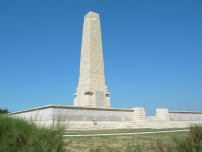| First Name: | Joseph | Last Name: | EDWARDS | |
|---|---|---|---|---|
| Date of Death: | 08/08/1915 | Lived/Born In: | Vauxhall | |
| Rank: | Corporal | Unit: | West Yorkshire9 | |
| Memorial Site: | Helles Memorial, Gallipoli | |||
Current Information:Age-20 21, Lennox Buildings, Wandsworth Road, Vauxhall
Gallipoli 1915 On 25 April, British, Australian and New Zealand forces landed on the Gallipoli peninsula. The plan was that these forces would soon defeat a demoralised Turkish army, knock Turkey out of the war, open up the Mediterranean to the Russian navy and threaten Austro-Hungary from the south. None of these things were achieved despite nine months of hard fighting in terrible conditions. It was a heroic failure. By July, 1915, and after much fierce fighting, stalemate had set in at Gallipoli both at Cape Helles where the British and French had landed and at Anzac Cove where the Australian and New Zealand Corps were unable to break out of their beach head. Fresh troops were needed and they were on their way in the shape of four divisions from Britain and things were put on hold until they arrived. The plan for August was for a landing at Suvla Bay to the north of Anzac Cove whilst at the same time, the ANZAC Corps, reinforced by some of the new British troops would effect a breakout from Anzac Cove and establish a line across the peninsula. Whilst this was going on the troops in the south at Helles would stage a number of diversionary attacks. But it all went horribly wrong and much of the reason for this can be explained by inadequate planning and leadership. Nobody seemed to know what they were supposed to be doing and Lieutenant-General Stopford, in charge of the Suvla landings was particularly out of his depth. The landings at Suvla failed to link up with the forces at Anzac and the breakout from there did not happen despite valiant efforts by all concerned. The loss of life on all fronts was again enormous. L.A. Carlyon’s excellent book “Gallipoli” gives a superb yet chilling account of the events. During the night of 6/7th August, 11th Division landed at Suvla when 32 and 33 Brigades came ashore on B Beach, south of Nibrunesi Point. The beach was undefended and after a line had been entrenched from the shore to the edge of the Salt Lake, units from 32 Brigade, including the 9th West Yorkshire battalion, attacked and captured Lala Baba Hill. On 7th August, two companies of 9th West Yorkshire remained on or near Lala Baba while the other two companies moved across to Hill 10 where they supported the attack by 9th Lancashire Fusiliers. The battalion was further split up when some platoons made their way north to the Kiretch Tepe hills while others moved towards the Chocolate Hills. Reorganised by the morning of 8th August, 32 Brigade began an advance to the line Sulajik-Anafarta Ova and 9th West Yorkshire and the 6th Yorkshire battalion occupied Scimitar Hill without meeting serious opposition. If 32 Brigade had then pushed on, W Hills (Ismail Oglu Tepe), a position of prime importance, could have been taken as Turkish reinforcements had still not arrived. But this advantageous situation had changed by the next day, 9th August, and when 9th West Yorkshire moved forward to higher ground which promised a better field of fire, they were attacked from the front and the flanks and driven off the slopes. They moved back to Sulajik and while doing so were attacked from Abrikya. Some remained defending Sulajik where they saw off strong Turkish counter attacks. The battalion suffered very heavy casualties and their situation was not helped by it being a very hot day with little water available to quench their thirst. One of those who did not survive this operation was Joseph Edwards who was killed in action on 8th August. |
||||
| « Back to Search Results | ||||
| If you think any of the information shown here is incorrect, Click Here to submit your amends and comments | ||||




